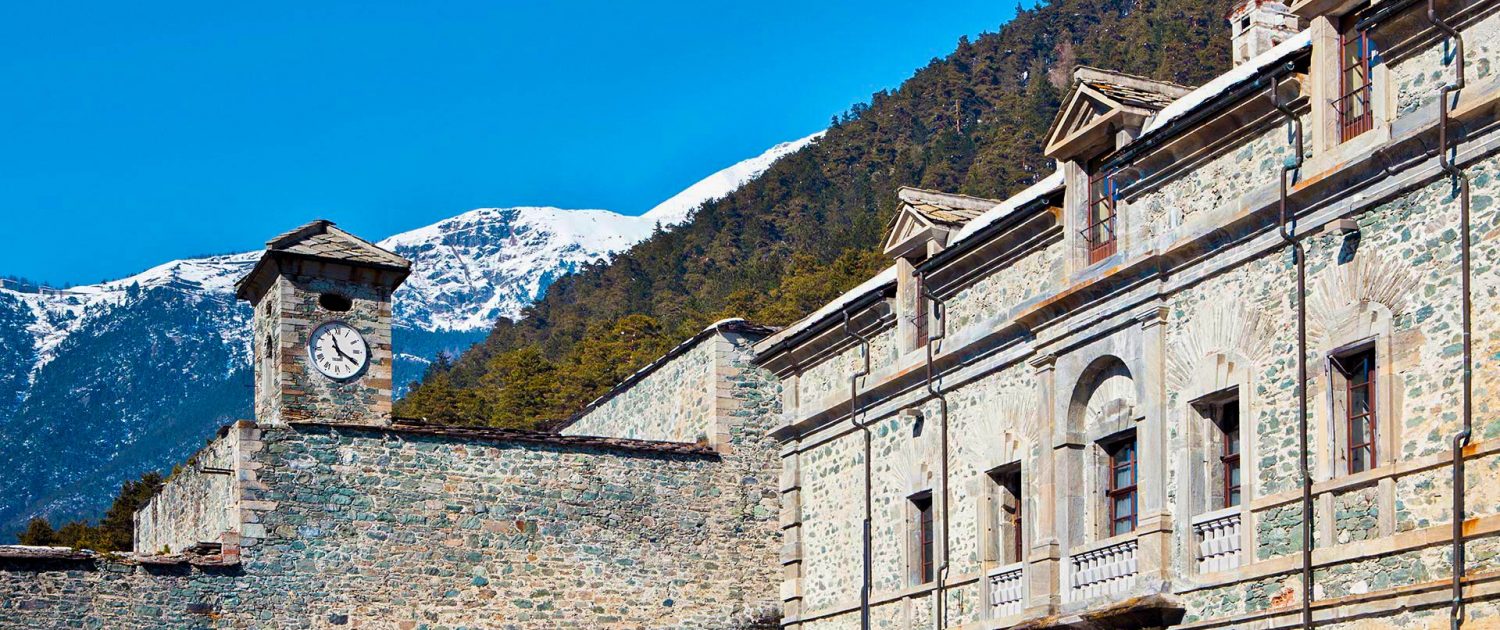Forts and History
Fort of Fenestrelle
The Fenestrelle Fortress overlooks the small village of Fenestrelle. It is the biggest alpine fortification in Europe, having a surface area of 1,300,000 m². The fortress was built by Savoy between 1728 and 1850 under the design of the architect Ignazio Bertola and it guards the access to Turin via the Chisone valley. It stands at an altitude between 1,100 and 1,800 m. The territory was acquired in 1709 by the Duchy of Savoy (later known as the Kingdom of Sardinia) after the defeat of the French at fort Mutin.
Fort of Exilles
Famed for housing the Man in the Iron Mask, the fort of Exilles is a fortified complex in the Susa Valley. Together with the nearby Fort of Fenestrelle and the Forte Albertino, it was part of the defensive line between the House of Savoy lands (later of the Kingdom of Italy) and France: both these states held it in different phases depending on the outcome of the various wars. It is located on a spur commanding one of the narrowest sections of the Susa Valley, along the main road connecting Turin to France.
French author Alexandre Dumas elaborated on the story of the Man in the Iron Mask in the novel The Vicomte of Bragelonne: Ten Years Later, the final installment of his classic D’Artagnan saga.
Fort Bramafam
The fort was built between 1886 and 1895 to protect the opening of the Frejus tunnel against possible attacks from the French. It was built on the site formerly occupied by a Dauphiné castle which was destroyed in 1574.
Before the fort was built, barbette batteries were made followed by the fort itself which hosted a garrison of about two hundred men.
Occupied by German troops after September 8, 1943, the fort was partially demolished after the peace treaty with France in 1947. After World War II, the structure fell into ruin.
In 1995 the Association of Military History and Architecture Studies took over the running of the fort, renovating it with the help of over 50,000 hours of volunteer work.
Military Road 79
Military road 79 is a road built in the high Susa valley (Alta Val di Susa) in 1886 to link Fenils Forte, Fort Pramand, Fort Foens and Fort Jafferau. Their task, in case of military attack by France, was to defend the valley of Bardonecchia and the outlet into the Val di Susa towards Cesana Torinese.
Part of this road (876 m ) runs under the Mount Seguret through the Saracens gallery. The gallery is currently closed to off-road traffic and pedestrians although there are talks of making it safe for passage once again.
Monte Genevris Bunkers
Easily seen on a hike to Monte Genevris from Sauze d’Oulx, these four Second World War bunkers were built to stop any military invasion along the Assietta Road (Strada dell’Assietta). Located between Colle Costa Piana and Monte Genevris, they were not equipped with any fixings and were eventually abandoned in 1941.
Strada dell’Assietta
The Assietta Road S. P. 173
Along the ridge that separates the Chisone Valley from the Susa Valley (above Sauze d’Oulx), the Assietta Road, or to give it its proper title Strada dell’Assietta, was a military carriageway that runs for some 60 km and almost entirely over 2000 meters.
The Strada dell’Assietta offers a unique chance to discover some of the most significant historical landmarks of one of the most striking corner of Western Alps. From the Escartons Republic to Savoy sovereignty, from religious conflicts to the rich biodiversity of alpine pastures and the Gran Bosco National Park to the Via Alpina striking paths (www.via-alpina.com), to the cyclotourist and horse tourist trails; from the impressive fortified system to the avantgarde architectural and sacred art expressions of Upper Susa Valley.
Also see our separate page on Strada dell’ Assietta
Mont Chaberton
Mont Chaberton, about 30 minutes by car from Sauze d’Oulx to the approach path, is a 3,131 metres (10,272 ft) peak in the French Alps. Chaberton is easily recognisable by its pyramidal shape and flat top.
The ascent of Chaberton is a popular summertime hike.
Until 1947 Mont Chaberton was in Italy, located in the municipality of Cesana Torinese.
In 1883 Italy joined the Triple Alliance and started strengthening its defences against France. Between 1898 and 1910 Italian troops built an artillery battery on the summit that pointed towards France, in particular at the town of Briançon, and the pass to Italy over the Col de Montgenèvre. A road was built to the summit from the village of Fénils in the Susa Valley by soldiers and engineers led by Major Engineer Luigi Pollari Maglietta. They flattened to summit by about 6 metres to provide a surface for the eight towers. Their height of 12 metres was designed to overcome the highest snowfall recorded.
Each emplacement was manned by seven men, who were protected by a relatively lightly armoured dome because the battery was thought to be out of reach of conventional artillery. Eight 149mm guns were mounted in the individual masonry towers. The fort was dubbed the “Fort of the Clouds” because it was often hidden in the clouds.
During the First World War, when Italy entered the war alongside the Triple Entente, the guns were removed to be used on the front against the Austro-Hungarian Empire.
Under the Benito Mussolini‘s regime, Chaberton was rearmed again to threaten to Briançon. The French army installed four 280mm mortars dating back to the battle of Verdun in the First World War, divided into two batteries and camouflaged. Both sites were outside the view of the Italians. When Italy entered the Second World War, they bombarded the French positions around Briançon on 20 June, but Italian troops did not advance. Little damage was inflicted. Because of cloud on the peak, the French could not respond. On 21 June 1940 the 154th Artillery Regiment destroyed six of the eight turrets using their mortars. They were guided by observers on the nearby Mont Janus. Shell craters are still visible from the air on the slopes to the west of the mountain. The nine Italians were killed and 50 were wounded. Turrets 7 and 8 continued to fire over the next three days, until the cease-fire of 24 June 1940.
The fort was abandoned 8 September 1943. It was briefly re-occupied in autumn 1944 by paratroopers of the Italian Social Republic.
At the end of the war France acquired the mountain, and the border was moved to the edge of the Italian village of Claviere. In 1957 all the remains of the guns and armour were removed. The masonry that supported the turrets is still visible. The remaining underground structures are in a dangerous condition.
Please note: all information is provided in good faith. Errors and omissions excepted. Be aware that exploring mountain environments can be dangerous. You are solely responsible for your own safety.


